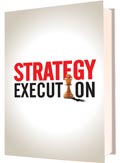Popular Searches
Useful Links
Supply Chain Management Case Study
Case Title:
Tata Indica: Stretching & Leveraging Resources
Publication Year : April 2010
Authors: S Sen
Industry: Automobiles
Region:India
Case Code: SCM0006IRC
Teaching Note: Not Available
Structured Assignment: Available
Abstract:
Competitiveness today does not stem from the size of a corporates resource pool; but from the gap that exists between its present resources and its aspirations. Creating stretch, a misfit between resources and aspirations, is the single most important task top management faces today. The top management can leverage its resources to meet the resource gap in five distinct ways - by concentrating, accumulating, complementing, conserving and recovering existing resources wherever possible. Stretching undoubtedly begets risk, but alternatively, it also provides a framework on how resources can be used to build competitive advantage. Tata Motors (previously known as TELCO) provides a rare glimpse on how a company operating in an emerging market can achieve this. A company basically into the manufacturing of commercial vehicles faced a saturated market, falling profits, and plummeting stock prices during the period (1994-1996). The company aspired to move into passenger cars. Though the two businesses shared the same Standard Industry Code (SIC), they were strategically different. Therefore, a potential resource gap was created. Its existing resources and capabilities were not sufficient to take care of the company's aspirations and goals.
Pedagogical Objectives:
-
This case study attempts to achieve the following pedagogical objectives:
- How the company leveraged its existing resource base to plug the resource gap and transform the company into a new growth trajectory.
- To analyse the position of GHAC in the Chinese automobile market.
- To highlights potential issues regarding outsourcing and supply chain management (SCM).
- The role of top management in this successful transformation has also been dealt with..
Keywords : Tata Group, Automobiles - emerging market, Business integration, Supply chain management, Resource gap, Resource stretch and leverage, Innovation, Transformational leadership, Strategic alliance, Outsourcing, Synergy, Capability, Value-chain, Strategy implementation, Performance
Contents:
|
|
Related Case Studies
Recently Bought Case Studies

 Strategy Execution
Strategy Execution
Price: $50
Hardcover edition
ISBN 978-81-314-2457-5 Managing in Troubled Times - Vol. I
Managing in Troubled Times - Vol. I
Price: $30
Hardcover edition
ISBN 81-314-0319-X Managing Innovation - Vol. I
Managing Innovation - Vol. I
Price: $50
Hardcover edition
ISBN 81-314-0603-2- View all Casebooks »
Case Studies On
 Course Case Mapping For Managerial Economics
Course Case Mapping For Managerial Economics
Price: $Course Case Mapping For Managerial Economics - I
Hardcover edition Course Case Mapping For Quantitative Methods
Course Case Mapping For Quantitative Methods
Price: $Course Case Mapping For Quantitative Methods - I
Hardcover edition Course Case Mapping For Marketing Management - II
Course Case Mapping For Marketing Management - II
Price: $Course Case Mapping For Marketing Management - II - I
Hardcover edition- View All Course Casemaps>
Course Case Mapping For
 An interview with Mir Ranjan Negi, Former Indian Hockey Coach
An interview with Mir Ranjan Negi, Former Indian Hockey Coach
Price: Rs.1000 An Interview with Dr.Rajiv Malhotra & (Prof)Dr.M.P.Sharma
An Interview with Dr.Rajiv Malhotra & (Prof)Dr.M.P.Sharma
Price: Rs.1000 An interview with Ed Cohen, Chief Learning Officer, Satyam Computer Services
An interview with Ed Cohen, Chief Learning Officer, Satyam Computer Services
Price: Rs.1000- View all Video Interviews»
Video Interviews
 Training and Development
Training and Development
Executive Brief with Anjali Mukherjee
Highly Recommended for Human Resource Management / Training and Development Course You Can’t Play by Rules, Always
You Can’t Play by Rules, Always
Executive Brief with R.D. Prasad, Product Manager.
Highly Recommended for Organizational Behavior Course New Recruit MBAs Attitudes
New Recruit MBAs Attitudes
Executive Brief with Lopamudra Ray, Keya Gupta and Deepika Lingala.
Highly Recommended for Organizational Behavior Course- View all Executive Briefs»
Executive Brief
 Colonel Steven Mains
Colonel Steven Mains
Colonel Steven Mains serves as the Director of the Center for Army Lessons Learned, part of the US Combined Arms Center at Fort Leavenworth, Kansas.
Speaks on Knowledge Management Don Sull
Don Sull
Donald N Sull is a Professor of Management Practice in Strategic and International Management at the London Business School.
Speaks on Strategy Execution Harish Bijoor
Harish Bijoor
CEO Harish Bijoor Consults, Inc.
Speaks on Social Cause Marketing- View All Executive Interviews»

